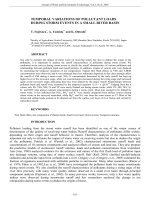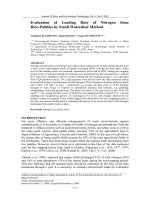small arms integration book (rifle accessories)
Bạn đang xem bản rút gọn của tài liệu. Xem và tải ngay bản đầy đủ của tài liệu tại đây (20.64 MB, 356 trang )
Small Arms
Integration Book
Prepared: 18 Aug 2000
ii
Page Intentionally Left Blank
iii
WARNINGS
AN/PAQ-4B/C Light, Aiming, Infrared
The AN/PAQ-4B/C is a military laser and has been exempted from FDA radiation safety performance
standards prescribed in the Code of Federal Regulations, Title 21 Chapter I, Subchapter J, pursuant
to exemption No. 76 EL-01 DOD issued on 7-26-76. These devices must be used IAW the
precautions contained in this manual.
The infrared beam is considered eyesafe based on military standards. Suitable precautions must be
taken to avoid overexposure to the infrared beam.
•
Do not stare into the infrared laser beam
•
Do not look into the infrared laser beam through binoculars or telescopes.
•
Do not shine the infrared laser beam into mirror surfaces.
•
Do not shine the infrared laser beam into other individual’s eyes.
Risk of Detection by Enemy: To reduce the risk of detection by an enemy wearing NVGs (Night
Vision Goggles), avoid prolonged activation of teh IAL (Infrared Aiming Light) prior to firing.
The infrared beam is more detectable to an enemy using NVGs when shining through smoke, fog and
rain. Avoid prolonged activation of the Aiming Light in these conditions.
AN/PEQ-2A Laser Pointers/Illuminators
Invisible Laser Radiation – Avoid Direct Exposure to the Beam
The AN/PEQ-2A makes use of a high power aiming laser and presents a serious eye hazard within
25 meters, when used in the training mode, and within 220 meters, when used in the tactical mode.
A safety block installed in the training mode (Blue Side Up) prevents teh operator from accessing the
iv
non eyesafe modes (AIM HI, DUAL LO/HI, DUAL HI/HI). A .050 hex head allen wrench is needed to
unscrew teh block from the body and re-install it in the tactical mode (Black Side Up). Tactical mode
should not be used unless authorized by the unit’s commander.
•
Do not stare into the infrared laser beam
•
Do not look into the infrared laser beam through binoculars, telescopes or 3x Extenders.
•
Do not point the infrared laser beam at mirror like surfaces.
•
Do not shine the infrared laser beam into other individual’s eyes.
Risk of Detection by Enemy
•
To reduce the risk of detection by an enemy using Night Vision Devices, avoid prolonged
activation of the AN/PEQ-2A.
•
The infrared beam is more detectable to an enemy using Night Vision Devices when used in
smoke, fog and rain. Avoid prolonged activation of the AN/PEQ-2A in these conditions.
•
Make sure the weapon is CLEAR and on SAFE before proceeding.
•
Do not store the AN/PEQ-2A with batteries installed.
•
Do not over adjust the adjusters.
AN/PAS-13 Thermal Weapon Sight (H/MTWS)
•
If operated with eyecup missing, light emitting from eyepiece may be visible to enemy night
vision devices.
•
Do not install a BA-5847 Lithium Sulfur Dioxide battery in the battery compartment. Cover may
rupture or fragment, causing serious injury in the event of battery venting.
v
•
DO NOT crush, puncture or otherwise mutilate battery. Avoid bringing battery into contact with
water. Turn battery in to unit maintenance for disposal in accordance with unit standard
operating procedures (SOP).
•
The AN/PAS-13 (H/MTWS) uses a primary (non-rechargeable battery) BA-5347/U battery or
secondary (rechargeable) BB2847/U battery. NEVER attempt to change a non-rechargeable
battery. To do so, may cause the battery to leak or vent.
•
Ensure weapon is not loaded and safety is on before installing and removing bracket/Thermal
Weapon Sight (AN/PAS-13 (H/MTWS)) to and from weapon. A loaded weapon may accidentally
discharge, causing injury or death.
•
Ensure safeties are in place before sight aligning weapon. Weapon may accidentally discharge,
causing injury or death.
•
Remove eye from eyecup before firing MK19 Grenade Machine Gun. Recoil of MK19 may
cause injury to personnel.
•
DO NOT touch, ingest or inhale particles of a broken lens. Lens contains germanium, which is
slightly toxic if ingested or inhaled. Glass may be sharp enough to cut personnel if touched.
•
Isopropyl alcohol is flammable and toxic. To avoid injury, keep away from open fire and use in a
well-ventilated area.
AN/PVS-4 Night Vision Sight
•
Rain, fog, sleet, snow, smoke, and other reflective matter impair the sight effectiveness.
•
DO NOT use without eye-guard attached or weapon recoil may cause personal injury.
•
Extreme care should be taken to see that no stray light is visible from sight when in operation (to
prevent detection by the enemy).
•
The batteries used in sight require special handling to avoid possible physical harm or
equipment damage. Return all used or damaged batteries to Property Disposal.
vi
•
The BA-5567/U (LITHIUM) battery contains sulfur dioxide gas under pressure and should be
handled in the following manner:
1. If the battery compartment becomes hot to touch and you hear a hissing sound (i.e.
battery venting) or smell irritating sulfur dioxide gas, IMMEDIATELY turn off the
equipment. Wait until battery has cooled before removing it.
2. DO NOT heat, puncture, disassemble, and test for capacity short circuit, attempt to
recharge, or otherwise tamper with battery.
3. Batteries have a safety vent to prevent explosion. When they are venting gas, you will
smell gas, your eyes may become irritated, or you may hear the sound of gas
escaping. When safety vents have operated, batteries are fairly safe from bursting,
but will be hot and must be handled with care.
4. DO NOT open plastic storage bag if cardboard box inside bag is stained or there is
liquid visible inside bag.
5. The Lithium battery has a black band around the top and bottom of plastic sleeve.
The lithium battery must be disposed of in accordance with local regulations.
6. DO NOT use batteries, which look bulged or have burst. Turn these batteries in to the
Property Disposal Office. Contact your unit safety officer for help with large quantities
of bulged or burst batteries.
7. DO NOT use water to extinguish lithium battery fire if a shock hazard exists due to
high voltage electrical equipment in the immediate vicinity (i.e., greater than 30 volts,
alternating current (ac) or direct current (dc).
8. DO NOT use two lithium batteries in the sight at the same time.
•
The image intensifier phosphor screen contains toxic materials.
•
A broken image intensifier may be caused from damage to the sight, especially if the sight
housing is cracked by force.
vii
•
If an image intensifier breaks, be extremely careful to avoid inhaling the phosphor screen
material. Do not allow the material to come in contact with the mouth or open wounds on the
skin.
•
If the phosphor screen material contacts your skin, wash it off immediately with soap and water.
•
If you inhale/swallow any phosphor screen material, drink a lot of water, induce vomiting, and
seek medical attention as soon as possible.
AN/PVS-10, Sight, Night Vision Sniper Scope (SNS)
•
DO NOT leave the lens caps open when SNS is not in use. This may permit detection by the
enemy.
•
Remove air pressure inside shipping/storage case by pressing pressure relief valve located near
carrying handle before opening the case.
•
DO NOT mix alkaline and lithium batteries. Failure to comply may result in injury or death.
•
Insure that only 1.5V batteries
are used. Use of 3.0V batteries may result in injury or damage
to the sight. DO NOT use 3.0V batteries
.
•
DO NOT disassemble the SNS, or personal injury and equipment damage may result.
•
DO NOT use the sight without eye-guard attached or personal injury from weapon recoil may
result.
AN/PVS-14 Monocular Night Vision Device
•
The image intensifier’s phosphor screen contains toxic materials.
1. If an image intensifier breaks, be extremely careful to avoid inhaling the phosphor
screen material. Do not allow the material to come in contact with the mouth or open
wounds on the skin.
2. If the phosphor screen material contacts your skin, wash it off immediately with soap
and water.
viii
3. If you inhale/swallow any phosphor screen material, drink a lot of water, induce
vomiting, and seek medical attention as soon as possible.
•
The IR source is a light that is invisible to the unaided eye for use during conditions of extreme
darkness. However, the enemy using night vision devices can detect the light from the
illuminator.
AN/TVS-5, Night Vision Sight
•
DO NOT press eye-guard except with eye area of face for operation of sight. Sight emits
illumination that can be detected by enemy if used improperly.
•
DO NOT use sight without eye-guard attached or personal injury from weapon recoil may result.
•
A lithium-sulfur dioxide (Li-SO2) battery used with the AN/TVS-5 contains pressurized sulfur
dioxide (SO2) gas. The gas is toxic, and the battery MUST NOT be abused in any way which
may cause the battery to rupture.
•
DO NOT heat, short circuit, crush, puncture, mutilate, or disassemble batteries.
•
DO NOT USE any battery, which shows signs of damage, such as bulging, swelling,
disfigurement, brown liquid in the plastic wrap, a swollen plastic wrap, etc.
•
DO NOT test LiSO2 batteries for capacity.
•
DO NOT recharge Li-SO2 batteries.
•
DO NOT use water to extinguish Li-SO2 battery fires if a Shock hazard exists due to high
voltage electrical equipment in the immediate vicinity [i.e., greater than 30 volts, alternating
current (ac) or direct current (dc)].
•
If the battery compartment becomes hot to the touch, if you hear a hissing sound (i.e., battery
venting), or smell irritating sulfur dioxide gas, IMMEDIATELY turn off the equipment. Remove
the equipment to a well-ventilated area or leave the area.
•
DO NOT use a Halon type fire extinguisher on a lithium battery fire.
ix
•
In the event of a fire, near a lithium battery(ies), rapid cooling of the battery(ies) is important.
Use a carbon dioxide (CO2) extinguisher. Control of the equipment fire, and cooling, may
prevent the battery from venting and potentially exposing lithium metal. In the event that lithium
metal becomes involved in fire, the use of a graphite based Class D fire extinguisher is
recommended, such as Lith-X or MET-L-X.
•
DO NOT store lithium batteries with other hazardous materials and keep them away from open
flame or heat.
•
In the event of contact with the eyes, immediately flush the eyes with water and continue to flush
for 15 minutes.
1. The first few seconds after contact are critical and immediate flushing of the eyes may
prevent permanent damage.
2. An eyewash fountain is preferred, but an eyewash hose or any other water source
should be used in an emergency
3. Alkali (base) burns are usually more serious than acid burns
4. Strong chemicals burn the skin rapidly. There is no time to waste. Flush the area with
water immediately. Remove and discard clothing, socks and shoes (obtain other
clothes and shoes). Continue to flood the area, while clothing is being removed.
M68 Close Combat Optic (CCO)
At higher intensity settings, red dot is visible through front of sight. For night vision operations, close
front lens cover before turning rotary switch to position 1 or 2. Check light for proper intensity before
opening front lens cover. Close front lens cover before turning rotary switch counterclockwise to the
OFF position. Failure to follow this warning could reveal your position to your enemy.
M145 Telescope, Machine Gun Optics (MGO)
•
Removal of the anti-reflection device (ARD) could lead to your detection by the enemy.
•
Use of the M145 Straight Telescope without laser filter is not eye-safe.
x
•
Ensure the reticule illumination is turned to the OFF position when not required.
•
Removal of the anti-reflection device (ARD) could lead to your detection by the enemy.
•
Removing the laser filter could result in the loss of your eyesight.
General Warnings
If devices are to be secured to the weapon by additional means (i.e. tape, rubber bands, etc.) insure
that the device is fully secured in its final configuration prior to conducting zeroing of the device to the
weapon. Failure to do so will result in an invalid zero and the firer’s inability to successfully engage
targets.
When handling any weapon always insure that the weapon has been cleared.
Periodically check the weapon mount to insure that it has not loosened during transportation or
operation.
Notes
There are four different rail grabber/mounts in the inventory.
−
Small Rail grabber/mount (For AN/PAQ-4B/C, AN/PEQ-2A & M204 Leaf Sight)
−
Large Rail grabber/mount (For AN/PVS-4)
−
TWS Rail grabber/mount (For AN/PAS-13, TWS)
−
AN/PSX-1 (CIDDS) Rail grabber for AN/PSX-1
xi
P
REFACE
This document is intended as a Leader’s Guide and quick reference for the soldier in the field. It is
our intent to provide a clear, easy-to-use document that outlines interface requirements between
weapons, their accessories and sights. This is a reference book and not intended to replace
Technical Manuals. Moreover, the information contained in this booklet provides baseline
configurations for the weapons and accessories covered. There are a wide variety of variations
possible, but only the baseline configurations will be discussed in this document. Detailed
procedures and guidance on the operation and employment of these devices is contained in the
appropriate Technical Manual. (See Annex A – References)
This book has been prepared using the most up-to-date data available and in some instances varies
from the information available in fielded Technical Manuals. When in doubt as to what configuration
should be used contact the below listed point of contact for further guidance:
Commander
United States Army Infantry School
ATTN: ATZB-CDE
Fort Benning, GA 31905-5400
Telephone: DSN 835-4952
COMM 706-545-4952
Feel free to disassemble this booklet and to reproduce those items required for training or
operations. The booklet has been formatted to specifically enhance your ability to reproduce the
information contained within.
xii
H
OW TO
U
SE THIS
B
OOKLET
Organization:
•
The Small Arms Integration Book is organized into Weapon Chapters (M16A2, M4/M4A1,
Modular Weapon System (MWS), M24, M249, etc.), with sections for each of the components
or sights contained in that chapter.
•
Each chapter starts with an overview photo of the weapon with all applicable Sights and
Accessories depicted. Lines indicate the general location of that item on the weapon.
•
Following the overview picture you will find sections for each of the components or
accessories associated with that weapon (AN/PAQ-4B/C, AN/PEQ-2A, AN/PVS-4, etc.).
•
Within a given section you will find a diagram and instructions explaining how to mount or
install the item on the weapon. Next you will find 25 meter zero targets and 10 meter bore
light.
•
Annexes contained at the rear of this booklet include:
−
A list of References (Annex A)
−
Accessory/Component Operating Instructions (Annex B)
−
Modular Weapon System Description (Annex C)
− Battery Quick Reference Guide (Annex D).
−
Airborne/Air Assault, Light and Mechanized Infantry Platoon Organization/Equipment
Diagrams (Annex E)
−
Borelight Alignment Procedure (Annex F)
−
Target Offset Summary (Annex G)
−
Acronyms and Abbreviations (Annex H).
xiii
Instructions:
1. Locate your weapon in the Table of Contents.
2. Locate the Sight or Accessory that you are attempting to mount or install below that weapon
then turn to the designated page.
3. Follow the instructions provided to install the Sight or Accessory. Use the diagram to the left
of the instructions to assist in your installation.
4. When preparing to qualify or familiarize with a Sight or Accessory refer to the appropriate 25-
meter zero target or Boresight target for correct preparation/configuration of the target for that
weapon/accessory combination.
5. If a confirmed boresight target is available (as indicated on the enclosed boresight targets) the
firer may omit the requirement to conduct a 25-meter live fire zero confirmation for the
AN/PEQ-2A and the AN/PAQ-4B/C. If however the firer is zeroing an AN/PAS-13, Thermal
Weapon Sight, or M68, Close Combat Optic, he must conduct a 25-meter live fire
confirmation to ensure proper mounting and alignment of the weapon/sight.
xiv
I
NTEGRATION
M
ATRIX
A checkmark indicates that the accessory or sight listed in the left-hand column is applicable
to the weapon listed at the top of the table.
Accessory
M16 A1/
A2
M16/
M203
M4/A
1
M4/
M203
MWS
(Note 1)
MWS
M203
M24
AN/PAQ-4B/C
(Note 2)
(Note 2)
AN/PAS-13, TWS
AN/PEQ-2A
AN/PVS-4(A)
AN/PVS-10, SNS
AN/PVS-14
AN/TVS-5
M68, CCO
M145, MGO
BIS
MILES
AN/PSX-1,
CIDDS
(Note 5)
Note 1 – MWS-Modular Weapon System (MWS) is a generic term that is applied to either a M4
Carbine with the M4 Adapter Rail System installed, or a M16A4 Rifle with the M5 Adapter
Rail System installed.
Note 2 - When mounting the AN/PAQ-4B/C to the M203 the Grenadier must first have the Quadrant
Sight removed.
xv
I
NTEGRATION
M
ATRIX
(C
REW
S
ERVED
W
PNS
)
Accessory M249 M60 M240B M2 MK19
AN/PAQ-4B/C
(Note 3)
(Note 3)
AN/PAS-13, TWS
AN/PEQ-2A
AN/PVS-4(A)
AN/PVS-10, SNS
AN/PVS-14
AN/TVS-5
M68, CCO
M145, MGO
(Note 4)
BIS
MILES
AN/PSX-1, CIDDS
(Note 5)
Note 3 – Objective configuration would be with the AN/PEQ-2A, however, the AN/PAQ-4B/C may be
used if the AN/PEQ-2A is unavailable.
Note 4 – The MGO will be used on the M249 only when the M249 is employed in the Light Machine
Gun role.
Note 5 - The AN/PSX-1 will replace the AN/PAQ-4B/C once the AN/PSX-1 device has been fielded.
xvi
T
ABLE OF
C
ONTENTS
WARNINGS III
AN/PAQ-4B/C L
IGHT, AIMING, INFRARED III
AN/PEQ-2A L
ASER POINTERS/ILLUMINATORS III
AN/PAS-13 T
HERMAL WEAPON SIGHT (H/MTWS) IV
AN/PVS-4 N
IGHT VISION SIGHT V
AN/PVS-10, S
IGHT, NIGHT VISION SNIPER SCOPE (SNS) VII
AN/PVS-14 M
ONOCULAR NIGHT VISION DEVICE VII
AN/TVS-5, N
IGHT VISION SIGHT VIII
M68 C
LOSE COMBAT OPTIC (CCO) IX
M145 T
ELESCOPE, MACHINE GUN OPTICS (MGO) IX
G
ENERAL WARNINGS X
N
OTES X
PREFACE XI
HOW TO USE THIS BOOKLET XII
INTEGRATION MATRIX XIV
INTEGRATION MATRIX (CREW SERVED WPNS) XV
TABLE OF CONTENTS XVI
xvii
INDIVIDUAL WEAPONS 0
M16A2 S
YSTEM DIAGRAM 1
M16A2—AN/PSX-1 (CIDDS) Mount Procedures 3
M16A2—AN/PAQ-4B/C Mount Procedures 6
M16A2—AN/PAS-13 (H/MTWS) Mount Procedures 9
M16A2—AN/PEQ-2A Mount Procedures 13
M16A2—AN/PVS-4 Mount Procedures 16
M16A2—M68, Close Combat Optic (CCO) Mount Procedures 19
M16A2—M203 Grenade Launcher 22
M4/M4A1 S
YSTEM DIAGRAM 32
M4/M4A1—AN/PAQ-4B/C Mount Procedures 33
M4/M4A1—AN/PSX-1 Interrogator Set Mounting Procedures 36
M4/M4A1—AN/PAS-13 (H/MTWS) Mount Procedures 39
M4/M4A1—AN/PEQ-2A Mount Procedures 42
M4/M4A1—AN/PVS-4 Mount Procedures 45
M4/M4A1—M68/ Mount Procedures 48
M4/M203A1 G
RENADE LAUNCHER 52
M4/M203—AN/PAQ-4B/C Mount Procedures 53
M4/M203—AN/PVS-4 Mount Procedures 56
M
ODULAR WEAPON SYSTEM DIAGRAM 60
MWS—AN/PAQ-4B/C Mount Procedures 61
MWS—AN/PSX-1 Interrogator Set Mounting Instructions 66
MWS—AN/PAS-13 (H/MTWS) Mount Procedures 71
MWS—AN/PEQ-2A Mount Procedures 76
MWS—AN/PVS-4 Mount Procedures 81
xviii
MWS—AN/PVS-14 Mount Procedures 86
MWS—M68, CCO Mount Procedures 88
MWS Grenade Launcher 93
M24 S
YSTEM DIAGRAM 111
M24—AN/PVS-10, Sight, Night Vision Sniper Scope Mount Procedures 112
M24—Sniper System Day Optic Mounting Instructions 115
M249 M
ACHINE GUN SYSTEM/SQUAD AUTOMATIC WEAPON DIAGRAM 118
M249—AN/PSX-1 (CIDDS) Mount Procedure 119
M249—AN/PAQ-4B/C Mount Procedures, Integrated Feed Tray Cover 125
M249—AN/PAQ-4B/C Mount Procedures, Units with AN/PAS-13 (H/MTWS) 128
M249—AN/PAQ-4B/C Mount Procedures Units without AN/PAS-13 131
M249—AN/PEQ-2A Mount Procedures, Integrated Feed Tray Cover 134
M249—AN/PEQ-2A Mount Procedures, Units with AN/PAS-13 (H/MTWS) 137
M249—AN/PEQ-2A Mount Procedures, Units without AN/PAS-13 (H/MTWS) 140
M249—AN/PAS-13 TWS Mount Procedures, Feed Tray Cover Rail 143
M249—AN/PAS-13 (MTWS) Mount Procedures 146
M249—AN/PVS-4 Mount Procedures, Integrated Feed Tray Cover 149
M249—AN/PVS-4 Mount Procedures, Units with AN/PAS-13 (H/MTWS) 152
M249—AN/PVS-4 Mount Procedures, Units without AN/PAS-13 (H/MTWS) 155
M249—M145 MGO Mount Procedures, Integrated Feed Tray Cover Rail 158
M249—M145, Machine Gun Optics Mount Procedures 161
M60 M
ACHINE GUN SYSTEM DIAGRAM 164
M60—AN/PAQ-4B/C Mount Procedures 165
M60—AN/PEQ-2A Mount Procedures 169
M60—AN/PVS-4 Mount Procedures 173
M60—AN/PAS-13 (MTWS) Mount Procedures 176
xix
M60—M145, Machine Gun Optic, Mount Procedures 179
M240B M
ACHINE GUN SYSTEM DIAGRAM 182
M240B—AN/PSX-1 Interrogator Mount Procedures 183
M240B—AN/PAQ-4B/C Mount Procedures 189
M240B—AN/PEQ-2A Mount Procedures 192
M240B—AN/PVS-4 Mount Procedures 195
M240B—M145, Machine Gun Optic, Mount Procedures 198
M240B—AN/PAS-13 (MTWS) Mount Procedures 201
M2 M
ACHINE GUN SYSTEM DIAGRAM 204
M2—AN/PEQ-2A Mount Procedures 205
M2—AN/TVS-5 Mount Procedures 208
M2—AN/PAS-13 (HTWS) Mount Procedures 211
MK19 G
RENADE
M
ACHINE
G
UN
S
YSTEM
D
IAGRAM
215
MK19—AN/PEQ-2A Mount Procedures 216
MK19—AN/TVS-5 Mount Procedures 219
MK19—AN/PAS-13 (HTWS) Mount Procedures 222
ANNEX A – REFERENCES 226
ANNEX B—SIGHT/ACCESSORY OPERATING INSTRUCTIONS 229
AN/PAQ-4B/C, L
IGHT AIMING, INFRARED 229
AN/PEQ-2A, T
ARGET POINTER ILLUMINATOR/AIMING LIGHT 233
AN/PVS-4, N
IGHT VISION SIGHT, INDIVIDUAL SERVED WEAPON 238
AN/TVS-5, N
IGHT VISION SIGHT, CREW SERVED WEAPON 242
M203 G
RENADE LAUNCHER 244
xx
M68-C
LOSE COMBAT OPTIC 246
M145 M
ACHINE GUN OPTIC 251
M145, MGO Zero Procedures 255
MILES – M
ULTIPLE INTEGRATED LASER ENGAGEMENT SYSTEM 258
AN/PVS-14, M
ONOCULAR NIGHT VISION DEVICE 264
AN/PAS-13 T
HERMAL WEAPON SIGHT 269
AN/PAS-13 Zero and Boresight Targets Preparation Procedures 271
AN/PVS-10, S
IGHT, NIGHT VISION SNIPER SCOPE (SNS) 275
AN/PSX-11, I
NTERROGATOR-TRANSPONDER SET (AN/PSX-1 (CIDDS)) 281
ANNEX C - MODULAR WEAPON SYSTEM 283
M4 C
ARBINE
V
ERSION
283
M16 V
ERSION MODULAR WEAPON SYSTEM 285
M203 C
OMPONENTS-MODULAR WEAPON SYSTEM 287
ANNEX D – BATTERY QUICK REFERENCE GUIDE 290
ANNEX E – PLATOON ORGANIZATION MATRIX 293
A
IRBORNE/AIR ASSAULT INFANTRY PLATOON 293
L
IGHT INFANTRY PLATOON 295
M
ECHANIZED INFANTRY PLATOON (BRADLEY) 297
F
ORCE XXI (3X9) MECHANIZED INFANTRY PLATOON 299
ANNEX F-BORELIGHT DRY ZERO PROCEDURES 302
xxi
ANNEX G - TARGET OFFSET SUMMARY 316
ANNEX H - ACRONYMS AND ABBREVIATIONS 330
I
NDIVIDUAL
W
EAPONS
1
M16A2 System Diagram
2
This Page Intentionally Left Blank
3
M16A2—AN/PSX-1 (CIDDS) Mount Procedures
Cable Mount Assembly
ACTIVATION & CONTROL CABLE
AN/PSX-1
M16A2 – AN/PSX-1 Interrogator Set Mounting Instructions
The AN/PSX-1 Interrogator Set is mounted to the M16A2 utilizing Bracket Assembly (Part No.
A
3259265, NSN 5855-01-446-9545) and AN/PSX-1 (CIDDS) Mounting Rail (Part No.
6451509).
1. Install AN/PSX-1 (CIDDS) Mounting Rail (Part No. 6451509) on barrel clamp posts
extending through top hand guard. (
Note
: Unit armorer installs barrel clamp.)
2. Secure the AN/PSX-1 to the rail with the rail grabber-clamping knob
3. Using AN/PSX-1 (CIDDS) cable mount assembly (Part No. 6451530), attach cable to
back of AN/PSX-1 and cable brackets to preferred side of weapon handguard.









